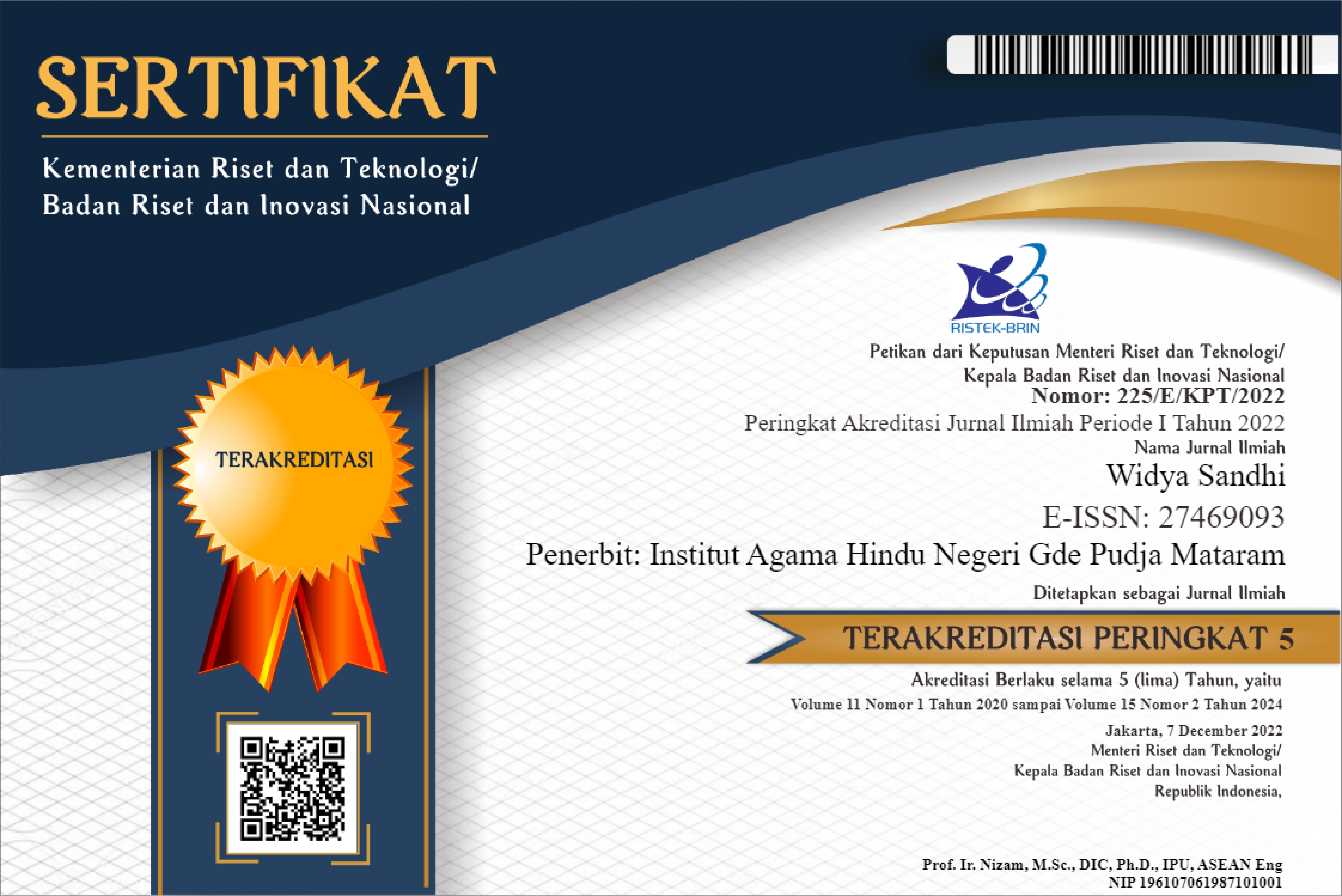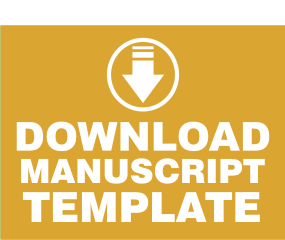TRADISI MESEMBEQ DALAM PELAKSANAAN RITUAL PADA UMAT HINDU DI KOTA MATARAM
Abstract
This study aims to conduct a study of the mesembek tradition carried out by Hindus in Mataram City. This research was designed in descriptive qualitative research by focusing on case studies. Based on the results of the study it was found that the background of the mesembeq tradition to Hindus in the city of Mataram was to enhance sradha (belief, faith) and bhakti (worship, respect) as cultural preservation. The function of the mesembeq tradition in Hindus in the city of Mataram, which has a religious function and serves as a defense of the identity of Hindus in the city of Mataram. The meaning of the mesembeq tradition in Hindus in the city of Mataram, which is meaningful to develop the traits that are Brahma, Wisnu and Iswara / Siwa. Lord Brahma, which is the manifestation of Ida Sang Hyang Widhi Wasa / God Almighty as the creator, symbolized in red colour, in sembeq, red is found in betel nuts, this symbol means that people who use sembeq have the creativity and creation in their lives, can create good and positive things for the life of mankind and the universe. The ingredients of betel leaves, according to the color are symbolized by dark colors, in the spider, the symbol of Lord Vishnu. The nature of Dewa Vishnu that needs to be manned by mankind is nurturing. People who use sembeq are expected to have a sense of love and affection for all beings, such as Lord Vishnu guarding the existence of the universe. Chalk is used as an ingredient for making sembeq, white is a symbol of Iswara / Siwa deity. The use of lime in making edible food so that its users are active in innovating, have the initiative to make a life change towards a better direction, always carry out the truth, make changes towards better.
References
Bagus, I Gusti Ngurah, 2000. Dinamika Budaya Hindu Dharma Di Indonesia. Yogyakarta : Dura Wacana University Press.
Bungin, Burhan, 2006. Analisis Data Penelitian Kualitatif. Jakarta : Raja Grafindo Persada.
Devaraja, N, K, 1974. Philosophy Religion and Culture. India : At Bhargava Bhushan Press.
Geertz, Clifford, 2001. Abangan, Santri, Priyayi dalam Masyarakat Jawa, terjemahan. Aswab Mahasin, Bandung: Dunia Pustaka Jaya.
Gulo, W, 2004. Metodologi Penelitian. Jakarta : Gramedia.
Harsojo, 1971. Pengantar Antropologi. Jakarta : Gramedia.
Kajeng, I Nyoman, dkk, 2005. Sarasamuccaya Dengan Teks Bahasa Sansekerta dan Jawa Kuna. Surabaya: Paramita.
Koentjaraningrat, 1980. Kebudayaan Mentalitas dan Pembangunan. Jakarta : Gramedia Pustaka Utama.
Miarta, Putra, I Nyoman, 2009. Mitos-Mitos Tanaman Upakara. Denpasar: PT. Pustaka Manik Geni.
Muhni, Imam, Djuretna A, 1994. Moral Dan Religi Menurut Emile Durkheim dan Henri Bergson. Yogyakarta:Kanisius.
O’Dea, Thomas, E,1985. Sosiologi Agama Suatu Pengantar Awal. Jakarta : CV. Rajawali.
Pendit, S, Nyoman. 2002. Bhagavad Gita. Jakarta : CV. Pelita Nursatama Lestari.
Pudja, Gde, 2002. Manawa Dharmacastra. Jakarta : CV. Pelita Nursatama Lestari.
Putra, Rai, Ida Bagus, 2009. Parama Dharma Dharmayatra Dang Hyang Nirartha. Swasta Nulus.
Ratiaksa, I Wayan, 2012. Bolong dan Gilik Dalam Perspektif Hindu. Denpasar: CV. Dwicipta Mediatama.
Ritzer, George, 2014. Teori Sosiologi Modern. Jakarta : Kencana.
Rudia, Adiputra, I Gede dkk, 2004. Dasar-Dasar agama Hindu. Jakarta : Lestari Karya Megah.
Saifudin, Anwar, 2001. Metodologi Penelitian. Pustaka Pelajar: Yogyakarta.
Soelaman, Joesoef, 1992. Konsep Dasar Pendidikan informal. Jakarta: Bumi Aksara.
Subagyo, Joko, 2006. Metode Penelitian Dalam Teori dan Praktek. Jakarta : Rineka Cipta.
Subama, M dan Sudrajat, M. 2005. Dasar-Dasar Penelitian Ilmiah. Bandung : Pustaka Setia.
Sugiyono, 2008. Metode Penelitian Kuantitatif-Kualitatif Dan R & D. Bandung: Alfabeta.
Suhardana, 2006. Etika dan Moralitas Hindu Bahan Kajian Untuk Memperbaiki Tingkah Laku. Surabaya : Paramita.
Tim Penyusun, 1998. Peninggalan Sejarah dan Kepurbakalaan NTB. Mataram: Proyek Pengembangan Media Kebudayaan Direktorat Jendral Kebudayaan. Departemen Pendidikan dan Kebudayaan RI.
Wiana, I Ketut, 1995. Yajña dan Bhakti. Denpasar : Manikgeni.
Wiana, I Ketut, 1997. Memelihara Tradisi Veda, Denpasar : Balai Pustaka.
Widana, Gusti Ketut, 2002. Lima Cara Beryajña.Denpasar : PT. BP.
Wijaya, I, Gede, 1981. Upacara Yajña Agama Hindu. Denpasar : Setia Kawan.
Wirata, I Wayan, 2010.Hegemoni Pemerintah dan Resistensi Wetu Telu Suku Sasak Di Kecamatan Bayan Kabupaten Lombok Barat. ”Disertasi” Denpasar : Program Pascasarjana Universitas Udayana.
Wirawan, I W.A. 2006. ”Dinamika dalam Sistem Simbol keagamaan pada Komunitas Hindu di Kota Mataram, Provinsi Nusa Tenggara Barat: Sebuah Kaian Budaya”. Denpasar: Tesis Program Pascasarjana Universitas Udayana
Sumber Internet :
http://khairul/2014/01/tindakan-sosial-menurut-max-weber.html, diunduh pada tanggal 6 Pebruari 2019.
https://sejarah-lengkap-kerajaan-mataram-lombok/, diunduh pada tanggal 10 April 2019

This work is licensed under a Creative Commons Attribution-NonCommercial-ShareAlike 4.0 International License.
Authors who publish with this journal agree to the following terms:
- Authors retain copyright and grant the journal right of first publication with the work simultaneously licensed under a Creative Commons Attribution-ShareAlike 4.0 International License. that allows others to share the work with an acknowledgment of the work's authorship and initial publication in this journal.
- Authors are able to enter into separate, additional contractual arrangements for the non-exclusive distribution of the journal's published version of the work (e.g., post it to an institutional repository or publish it in a book), with an acknowledgment of its initial publication in this journal.
- Authors are permitted and encouraged to post their work online (e.g., in institutional repositories or on their website) prior to and during the submission process, as it can lead to productive exchanges, as well as earlier and greater citation of published work (See The Effect of Open Access).






.jpg)




